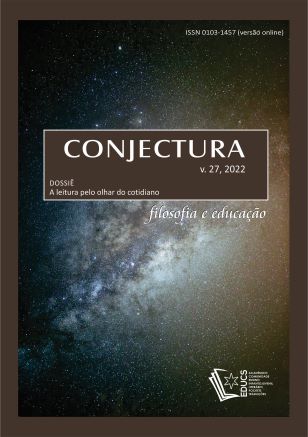Literature and its modes of reading: the literary mediation for high school students
DOI:
https://doi.org/10.18226/21784612.v27.e022001Keywords:
Literary reading, Reading Mediation, Reading Modes.Abstract
This article discusses reading workshops conducted with firstyear high school students from a public school and a private school in the city of Dourados/MS (Brasil). The workshops were constituted by texts that reconfigured the character Little Red Riding Hood over time, and the reading mediation aimed to seek, in the students’ interpretations, new readings about the texts: Little Red Riding Hood, in the versions of Charles Perrault and the brothers Grimm; besides the tale Green Ribbon on Hair – Nova Velha História, by Guimarães Rosa. The expectation was to understand the students’ ability to use the Reading Modes defended by Rildo Cosson (2014) as mechanisms to interpret literary texts in their inquiries during activities. Therefore, here we present the analysis of the audio transcriptions recorded during the Reading Workshops. The adopted methodology is based on the studies of Alves and Silva (1992) for qualitative analyzes. In the end, we conclude that students from public and private schools use Reading Modes for interpretations of literary texts, however, the former are more playfully attached to the texts, without resorting to literary theories for their interpretations, while the others, more knowledgeable about theories and concepts of literature, make their interpretations less personal and more practical. As a theoretical framework, we dialogue with Cosson (2014) and the Basic Education Curriculum Framework of the State Education Network / MS – High School (2012), among others.
References
ABREU, Márcia. Leituras no Brasil: antologia comemorativa pelo 10º Cole. Campinas/SP:Mercado das Letras, 1995.
ALVES, Zélia Maria Mendes Biazoli. SILVA, Maria Helena F. F. Dias. Análise qualitativa de dados de entrevista: uma proposta. São Paulo: Paideia, N. 2, Fev./Jul. 1992. Disponível em:<http://www.scielo.br/scielo.php?script=sci_arttext&pid=S0103-863X1992000200007>. Acesso em 15 de julho de 2019.
BRASIL. MEC. ANDIFES. V Pesquisa sócioeconômico e cultural dos estudantes de graduação das instituições federais de ensino superior brasileiras, 2018.
BRASIL, Ministério da Educação, (2006). Parâmetros curriculares nacionais para o ensino médio. Brasília, MEC/SEF.
COSSON, Rildo. Letramento literário: teoria e prática. São Paulo: Contexto, 2009.
COSSON, Rildo. Círculos de leitura e letramento literário. São Paulo: Contexto, 2014.
DAUSTER, Tania. Jogos de inclusão e exclusão sociais: Sobre leitores e escritores do final do século XX no Rio de Janeiro. IN: YUNES, Eliana. A experiência da leitura. São Paulo: Edições Loyola, 2003.
FREIRE, Paulo. A importância do ato de ler: em três artigos que se completam. 22 Ed. São Paulo: Cortez, 1988.
GALVÃO, André Luis Machado. SILVA, António Carvalho. A motivação para a leitura na escola: contribuições para o ensino de literatura. Revista a cor das letras, Braga/PT, v. 18, n.3, p. 27-42, set-dez, 2017.
GERALDI, João Wanderley (Org.). O texto na sala de aula. 4. Ed. São Paulo: Ática, 2006.
MATO GROSSO DO SUL. Secretaria de Estado de Educação. Referencial Curricular da Educação Básica da Rede Estadual de Ensino/MS - Ensino Médio. Mato Grosso do Sul: SED, 2012
PERRAULT, Charles. Contos da mamãe Gansa ou históricas do tempo antigo. São Paulo: Editora Sesi-SP, 2018.
PETIT, Michèle. Os jovens e leitura: uma nova perspectiva. 2. ed. São Paulo: 34, 2009.
ROSA, Guimarães. Fita verde no cabelo: Nova velha história. Rio de Janeiro: Editora Nova Fronteira, 2013.
YUNES, Eliana (Org.). Pensar a leitura: complexidade. Rio de Janeiro: PUC-Rio, 2002.
YUNES, Eliana. A experiência da leitura. São Paulo: Edições Loyola, 2003.
ZOARA, Failla. (org.). Retratos de leitura do Brasil 4, Rio de Janeiro: Sextante, 2016.
Downloads
Published
How to Cite
Issue
Section
License
1. The publication of the originals will imply the assignment of copyright to Conjectura Journal.
2. Texts cannot be reproduced without authorization from the Journal after acceptance.









